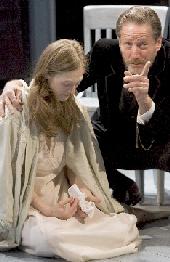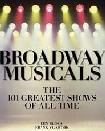SEARCH CurtainUp
REVIEWS
FEATURES
NEWS
Etcetera and
Short Term Listings
LISTINGS
Broadway
Off-Broadway
BOOKS and CDs
OTHER PLACES
Berkshires
London
LA/San Diego
DC
Philadelphia
Elsewhere
QUOTES
On TKTS
LETTERS TO EDITOR
FILM
LINKS
MISCELANEOUS
Free Updates
Masthead
Writing for CurtainUp NYC Weather
Sabina
|
I have not been disloyal to you .--- Jung You've been loyal to your ambition.---Sabina What would it mean if I published you?---Jung That you still think of me as a patient. That you've passed me by.---Sabina This exchange after Sabina has been successfully psychoanalyzed by Jung and has become his lover and enrolled as a medical student who will herself become a respected psychiatrist. Sabina not only feels betrayed by Jung's plan to publish her case history but argues that rather than his having chosen her as a patient she chose him. When Jung argues that he could not make "a gift of madness" she counters with "I made a gift of sanity." |

Marin Ireland and Peter Strauss
(Photo: James Leynse) |
Until recently Dora and Anna O were probably the names that first came to mind in relation to famous psychoanalytic case histories. Both were among the women famously analyzed by Freud. It took the publication of John Kerr's A Most Dangerous Method (1993) and Aldo Carotenuto's A Secret Symmetry: Sabina Spielrein Between Jung and Freud (1982) to draw public attention to an important early " talking cure" case. The analysand was a young Jewish woman, who'd been sent to a Zurich psychiatric hospital by her well-to-do Jewish parents in 1906. The analyst was Karl Jung, Freud's admirer and, at one time, his designated heir. (Legend has it that after they met, Freud canceled all his appointments for the day, and he and Jung talked for 13 hours straight with the meeting of these two great minds leading to Freud's seeing Jung as his crown prince).
Spielrein was not only successfully treated for her schizophrenia but herself became a noted psychiatrist. Furthermore, her cure involved a love affair with Jung (what professionals describe as counter transference) and a friendship with Freud that postdated the two men's falling out (with Freud remaining true to his sexual theories while Jung forumulated his own theory of "analytical psychology" and the "collective unconscious").
It was inevitable that stage and screen writers would see the dramatic potential in the story of Sabina Spielrein that was brought to light by the Carotenuto and Kerr books. Here was a new link to the famous professional feud. The triangular relationship between Spielrein, Jung and Freud had all the elements of a psychological thriller, wreathed in an aura of real history and sizzling with sexual passion.
The undercurrents of anti-Semitism lend further fuel to the dramatic fire. For Freud the prevailing attitude towards Jews threatened to undermine the influence of the science he pioneered; for Jung, it led to accusations that haunted him all his life, especially since he had a misguided association with the Nazis; and for Sabina Spielrein, being Jewish brought death at the hands of the Nazis.
In addition to a documentary (My Name was Sabina Spielrein) and a film (still in the works), Willie Holzman's play is one of two about Spielrein's cure and her relationship with Jung and Freud. Reading our London and Los Angeles critics' review of Christopher Hampton's 2003 play The Talking Cure (see link below) heightened my regret at missing Holzman's Sabina during it's all too brief premiere in 1996. Happily Primary Stages has now brought an update of this engrossing drama to the main stage of its new home on East 59th Street.
Director Ethan McSweeny and designer Mark Wendland have created a production that, despite a smallish stage, has the physical sweep to match Holtzman's thirty-year spanning psycho-drama. A red velvet curtain that's frequently drawn open and shut, like a children's Punch and Judy show, envelops the central playing area. It also creates passage ways at either side of the stage for entrances and exits by Freud (Peter Strauss), Jung (Victor Slezak) and a third, also drawn from life, doctor, Ludwig Binswanger (Adam Stein). With just a few props, the central playing area suggest the shifts from the Burgholzi psychiatric hospital to Jung's examining and living room, a Zurich hillside, and a lecture hall at the Burgholzi hospital. The barnlike windows that overarch everything add a sense of the outside world's beckoning to the people struggling to free the demons and ideas struggling to fly out of those draped, enclosed rooms below.
As already mentioned, Marin Ireland gives a riveting performance. We first meet her as a crazed teenager who flaps at the cage of her troubled mind like a frightened, trapped bird. She emerges from her immensely watchable, filled with Wagnerian sturm and drang psychoanalysis as a brilliant young woman eager for life. By the time she meets Freud she is an irresistibly charming and obviously brilliant medical student. Ireland, who when I saw her in the theater lobby after the show looked as if she could be a student at nearby Hunter College, even brings off the mature Sabina quite convincingly.
While this is Ireland's star turn, the three doctors are all solid. Peter Strauss is a somewhat surprising Freud. This Freud is much more attractive than familiar textbook images and, especially during his first meeting with Sabina, he lathers on Viennese charm like a spoonful of schlag on a slice of sacher torte. At one point he actually waltzes with her. Strauss's Freud is also quite funny, bringing a welcome lighter mood to relieve the tension generated during the breakthrough in Sabina's analysis. Victor Slezak doesn't seem quite the right age for Jung, who was just ten years older than Sabina and twenty years' Freud's junior. At the performance I attended, he was not yet quite at home with all his lines but this will undoubtedly change as the run progresses.
Adam Stein's Dr. Binswanger may seem like a minor role, but Binswanger's function as both insider and observer of Jung's problematic personal involvement with Sabina adds texture and substance. Stein makes Binswanger memorable with an understated performance that brings out his character's dry humor, his Swiss-ness. The evening's first big laugh is elicited by an exchange between Binswanger and Sabina during her recovery period. He tells her that he's "off duty" and explains that term with a joke about Dr. Bleuler (the never seen hospital chief) applying his belief in work therapy. The joke falls flat with Sabina, but his dry "that sort of thing passes for humor in Switzerland" sets off loud chuckles from the audience.
McSweeny is a director who knows how to reinforce and further the action with all sorts of inventive touches. The placement of violinist Batya MacAdam-Somer at the front of the side balcony, in full view of the audience to play Michael Roth's lovely original music enhances what's happening on stage but without distraction. McSweeny's creative approach to Holtzman's emotionaly charged and often amusing faction and the fine acting make for two hours of lively theater.
For trivia collectors: The original production played for 41 performance at the old 45th Street venue. It was directed by Melia Bensussen and starred another excellent Marin -- Marin Hinkle -- as Sabina, George Bartenieff as Freud, Ken Marks as Jung and David Atkins as Binswanger.
For our London and Los Angeles critics' review of Christopher Hampton's dramatication of the story, see The Talking Cure in LondonThe Talking Cure in Los Angeles
| SABINA
Written by Willy Holtzman Directed by Ethan McSweeny Cast: Marin Ireland as Sabina, Peter Strauss as Freud, Victor Slezak as Jung; Adam Stein as Binswager. Set Design: Mark Wendland Costume Design: Michael Sharpe Lighting Design: Jane Cox Composer, Michael Roth Sound Design: Robert Kaplowitz Running time: Approximately 120 minutes 59 East 59th Street (Park & Madison) 212.279.4200 From 1/18/05 to 2/27/05; opening 2/02/05. Tuesday, 7pm; Wednesday-Friday, 8pm; Saturday, 2pm & 8pm; Sunday, 3pm; Wednesdays February 9 & February 23, 2pm instead of 8pm. Tickets: $55 Reviewed by Elyse Sommer based on January 28th press performance |

Easy-on-the budget super gift for yourself and your musical loving friends. Tons of gorgeous pictures.

Retold by Tina Packer of Shakespeare & Co.
Click image to buy.
Our Review

At This Theater

Leonard Maltin's 2005 Movie Guide

Ridiculous!The Theatrical Life & Times of Charles Ludlam

6, 500 Comparative Phrases including 800 Shakespearean Metaphors by CurtainUp's editor.
Click image to buy.
Go here for details and larger image.



